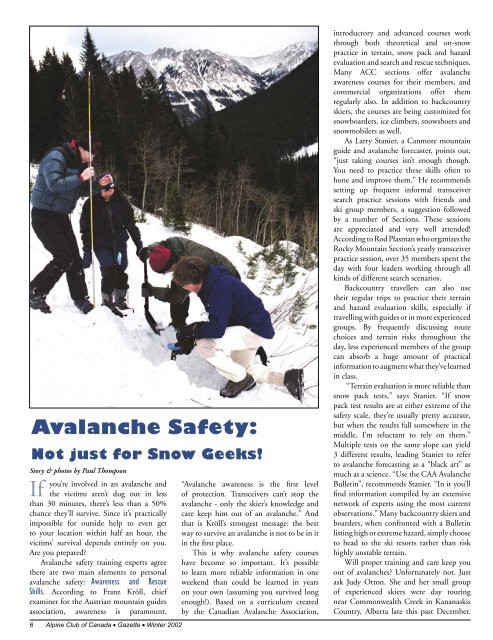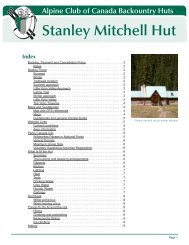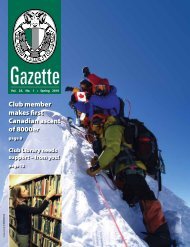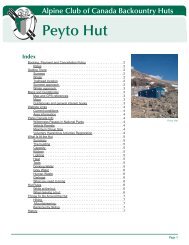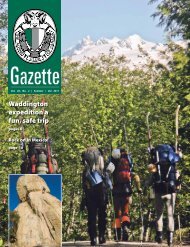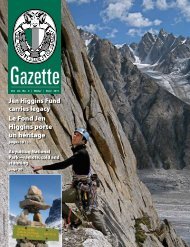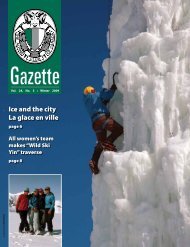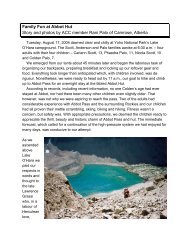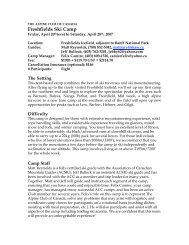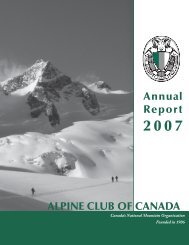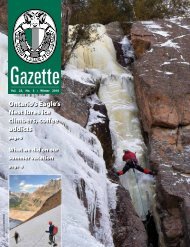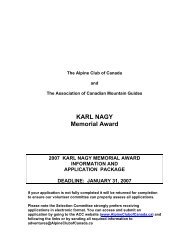Avalanche Safety: Avalanche Safety: - The Alpine Club of Canada
Avalanche Safety: Avalanche Safety: - The Alpine Club of Canada
Avalanche Safety: Avalanche Safety: - The Alpine Club of Canada
You also want an ePaper? Increase the reach of your titles
YUMPU automatically turns print PDFs into web optimized ePapers that Google loves.
<strong>Avalanche</strong> <strong>Safety</strong>:Not just for Snow Geeks!Story & photos by Paul ThompsonIfyou’re involved in an avalanche andthe victims aren’t dug out in lessthan 30 minutes, there’s less than a 50%chance they’ll survive. Since it’s practicallyimpossible for outside help to even getto your location within half an hour, thevictims’ survival depends entirely on you.Are you prepared?<strong>Avalanche</strong> safety training experts agreethere are two main elements to personalavalanche safety: Awareness and RescueSkills. According to Franz Kröll, chiefexaminer for the Austrian mountain guidesassociation, awareness is paramount.6 <strong>Alpine</strong> <strong>Club</strong> <strong>of</strong> <strong>Canada</strong> ● Gazette ● Winter 2002“<strong>Avalanche</strong> awareness is the first level<strong>of</strong> protection. Transceivers can’t stop theavalanche - only the skier’s knowledge andcare keep him out <strong>of</strong> an avalanche.” Andthat is Kröll’s strongest message: the bestway to survive an avalanche is not to be in itin the first place.This is why avalanche safety courseshave become so important. It’s possibleto learn more reliable information in oneweekend than could be learned in yearson your own (assuming you survived longenough!). Based on a curriculum createdby the Canadian <strong>Avalanche</strong> Association,introductory and advanced courses workthrough both theoretical and on-snowpractice in terrain, snow pack and hazardevaluation and search and rescue techniques.Many ACC sections <strong>of</strong>fer avalancheawareness courses for their members, andcommercial organizations <strong>of</strong>fer themregularly also. In addition to backcountryskiers, the courses are being customized forsnowboarders, ice climbers, snowshoers andsnowmobilers as well.As Larry Stanier, a Canmore mountainguide and avalanche forecaster, points out,“just taking courses isn’t enough though.You need to practice these skills <strong>of</strong>ten tohone and improve them.” He recommendssetting up frequent informal transceiversearch practice sessions with friends andski group members, a suggestion followedby a number <strong>of</strong> Sections. <strong>The</strong>se sessionsare appreciated and very well attended!According to Rod Plasman who organizes theRocky Mountain Section’s yearly transceiverpractice session, over 35 members spent theday with four leaders working through allkinds <strong>of</strong> different search scenarios.Backcountry travellers can also usetheir regular trips to practice their terrainand hazard evaluation skills, especially iftravelling with guides or in more experiencedgroups. By frequently discussing routechoices and terrain risks throughout theday, less experienced members <strong>of</strong> the groupcan absorb a huge amount <strong>of</strong> practicalinformation to augment what they’ve learnedin class.“Terrain evaluation is more reliable thansnow pack tests,” says Stanier. “If snowpack test results are at either extreme <strong>of</strong> thesafety scale, they’re usually pretty accurate,but when the results fall somewhere in themiddle, I’m reluctant to rely on them.”Multiple tests on the same slope can yield3 different results, leading Stanier to referto avalanche forecasting as a “black art” asmuch as a science. “Use the CAA <strong>Avalanche</strong>Bulletin”, recommends Stanier. “In it you’llfind information compiled by an extensivenetwork <strong>of</strong> experts using the most currentobservations.” Many backcountry skiers andboarders, when confronted with a Bulletinlisting high or extreme hazard, simply chooseto head to the ski resorts rather than riskhighly unstable terrain.Will proper training and care keep youout <strong>of</strong> avalanches? Unfortunately not. Justask Judy Otton. She and her small group<strong>of</strong> experienced skiers were day touringnear Commonwealth Creek in KananaskisCountry, Alberta late this past December.


